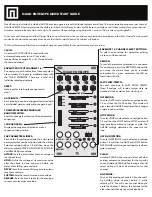
Tuning fork
8
EN
1 Intended use
Our products are exclusively intended for professional use by appropriately trained and
qualified personnel and may only be acquired by them.
A tuning fork is a u-shaped instrument, usually made of stainless steel, with a handle at
the base of the ´u´. The vertical prongs of the ´u´ are cut to a particular length to produce
sound of a specific wavelength when the ´u´ is struck against a hard object, usually
rubber. It is typically used during ear/nose/throat (ent) examinations to test hearing
acuity. This is a reusable device.
2 Application Notes
•
If possible, the tuning fork should be struck against the ball of the thumb or against
a piece of wood or plastic. Never strike it against hard objects (e.g. metal, steel or
stone). It is important that the striking is short and bouncy i.e., the tuning fork is
touched only briefly. The period of vibration of the sound achieves a maximum
period of time by this short striking.
•
Now the required examinations can be performed optimally.
•
If the tuning fork has fixed weights, they should not be removed. The frequency
changes by moving the weights and an exact adjustment can only carry out by the
manufacturer.
3 Cleaning
After use, the instrument should not be cleaned in sterilizers. To clean tuning forks, they
should be rubbed off with a dry or lightly oiled cloth.
4 Rydel-Seiffer-Tuning fork
4.1 HB 0183-01 Tuning fork with a C 64 damper and a c 128 base
The Rydel-Seiffer Tuning fork produces two different frequencies: note C = 64 Hz with
the dampers (as marked on the dampers) and note c = 128 Hz without the dampers (as
marked on the tuning-fork itself). The dampers must be fitted with the lower edge flush
with the gradation on the prongs. The imprint „C 64„ on the dampers, the imprint „c128„
on the front of the tuning-fork and the gradation must all be facing the user when the
damper is fitted. The knurled-head screws are tightened to fix the dampers and
slackened to remove them. They should be tightened firmly when the dampers are fixed.
On examination (sensitivity test, etc.):
After striking with the black the tuning fork will be placed on the points of the patients,
which will be examined.
On the back side of the tuning fork scales are fixed on the dampers. By observation of
these scales, the intensity of vibration of the tuning fork can begin each with the same
intensity of vibration.
Summary of Contents for HB 0181-06
Page 2: ......






























